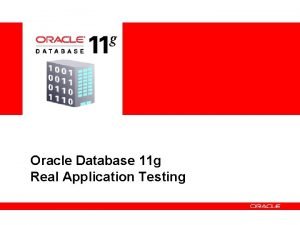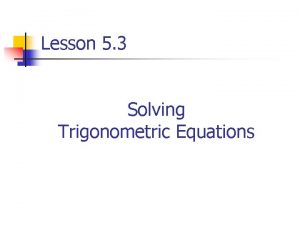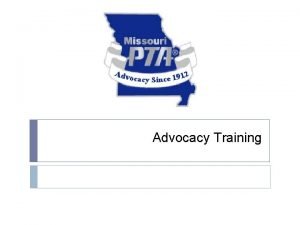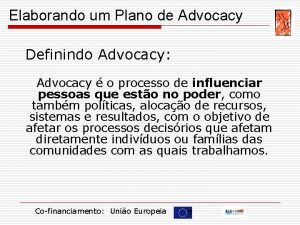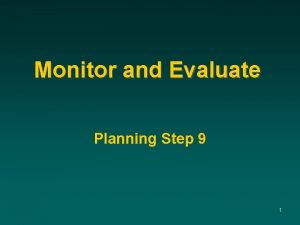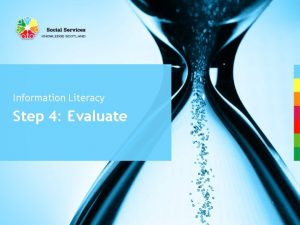Monitor and Evaluate Policy Advocacy Step 8 Develop





















- Slides: 21

Monitor and Evaluate Policy Advocacy

Step 8: Develop Monitoring and Evaluation Plan • Purpose: demonstrate progress toward your goals and objectives and define success for advocacy strategy • Consider the factors that make M&E of advocacy different • Decide on methods for collecting data and measuring success • Develop indicators for your advocacy strategy

“M” in M&E • Monitoring is the systematic process of collecting, analyzing, and using information/ data on specified project indicators to: – Track progress of project implementation – Track progress to reaching objectives – Account for the use of allocated funds – Guide management decisions • The information is used by project staff, management, and stakeholders.

“E” in M&E • Evaluation is the systematic collection and analysis of information about the characteristics and outcomes of programs to: – Make judgments, improve effectiveness, and inform decisions about current and future programming – Compare expected and achieved results – Examine contextual factors and causality to understand achievements or lack of achievement • Involves measuring changes in knowledge, attitudes, behaviors, skills, community norms, and use of services at the program or population level

Basic Logic Model Structure Resources/ Inputs Activities Outputs Outcomes Impact 1 2 3 4 5 Your Planned Work Your Intended Results

Logic Model Example—A Wedding Inputs Activities Outputs Outcomes Impact Couple Hire Vendors 600 photos taken Budget Write vows 1 marriage certificate signed Stronger family bonds for couple Venue Get married Family and friends Celebrate with friends and family 2 vows exchanged Couple: • Is married • Enjoyed time with family and friends • Had fun on their special day Go on a honeymoon 75 gifts received Vendors 200 guests fed Stronger family bonds for the families

Indicators • M&E requires the use of indicators. • Indicators define the data that you are collecting. Example: number of people sensitized on GBV and GBV services • An indicator is a variable (its value changes) that measures the components of a program or project (inputs, activities, outputs, outcomes ). • Indicators can be quantitative or qualitative.

Characteristics of Good Indicators • Valid: accurate measure of a behavior, practice, or task that is the expected output or outcome of the activity • Precise: operationally defined in clear terms • Measurable: quantifiable using available tools and methods • Reliable: consistently measurable in the same way by different observers

Characteristics of Good Indicators (continued) • Comparable: can be measured in different contexts or time periods • Time-bound: requires completion by a specific date • Programmatically important: Why do we want to know this? Is the information useful?

Monitoring & Evaluation for Advocacy Work Monitoring Routine tracking of inputs and outputs Is the advocacy strategy being executed according to plan and on budget? Are the activities still appropriate given external changes? Evaluation Measuring the changes resulting from program activities over time Is the advocacy having the intended effect on target audiences? What are the successes and failures? What is happening that you didn’t expect? Source: Building on the Easy Wins: A Framework for Planning and Evaluating Proactive Long-Term Policy Advocacy. Health Policy Project; 2016.

Types of Indicators for M&E of Advocacy • Process/output indicators: numbers/types of activities and quality determinants—what you will do and how you will do it Example: X different organizations contacted to participate in the coalition using best practices in engagement. • Interim outcome indicators: how you will know that attitudes, knowledge, and behavior of target audiences and allies have changed in the short and medium terms Example: X new partners have shared coalition-approved messages with targets. • Long-term outcome indicators: the policy change for which you have advocated Example: The local council approved policy change X with 85 percent of our preferred policy elements. Source: Building on the Easy Wins: A Framework for Planning and Evaluating Proactive Long-Term Policy Advocacy, Health Policy Project, 2016.

Logic Model with Sample Indicators Inputs Activities - Policy review Funding Staff Plans Training materials Indicators: - Engage new partners in coalition - Conduct community dialogues - Health provider sensitization trainings # of partners contacted Outputs - Partners engaged in coalition - Community dialogue held; topics listed - Providers trained and scored on attitudes # of partners engaged in coalition Outcomes - New partners actively sharing coalition messages - Positive feedback from dialogues - Improved attitude of providers - Friendly services Impact Enabling environment increases access and use of services by PLHIV # of new partners # of PLHIV sharing messages of accessing the coalition services

Distinctive Features of Advocacy M&E • Time frames can be unpredictable • Strategies and milestones shift • Assessing progress and interim outcomes is important; not just impact • Context may define progress and outcomes • Demonstrate contribution to results, not simply attribution Source: Advocacy Toolkit, UNICEF, 2010.

Methods to Evaluate Advocacy Traditional Unique Interviews Bellwether methodology Champion tracking Surveys Intense period debriefs Media scorecards Focus groups Critical incident timelines 360 -degree critical incident reviews Event observation Systems mapping Research panels Polling Policymaker ratings Social media tracking Case studies Intercept interviews Rapid response research Source: Building on the Easy Wins: A Framework for Planning and Evaluating Proactive Long-Term Policy Advocacy. Health Policy Project; 2016.

Method: Policymaker Ratings Support 1=Not at all supportive 2=Interested 3=Somewhat supportive 4=Supportive 5=Extremely supportive Influence 1=Not very influential 2=Somewhat influential 3=Influential 4=Extremely influential Confidence 1=Not very confident in the rating 2=Somewhat confident 3=Extremely confident NOTE: You must identify observable characteristics or behaviors that differentiate each “level” on the scale for consistency between raters and ratings. Developed by: Julia Coffman, Harvard Family Research Project.

Method: Systems Mapping • Useful when trying to track systems change Step 1 • Mapping of the parts and relationships of a system Step 2 Step 3 • Can involve mapping of a system, key informant interviews, or network analysis Adapted from: Measuring Up, A Guide for Learners. AIDS Alliance; 2010.

Example 1 Problem Statement: PLHIV in Malawi denied access to care, treatment, and support Advocacy Goal: Equal access to high-quality health services for all PLHIV in Malawi Advocacy Objective: MOH commits to adopting a policy of providing high-quality health services to all PLHIV Indicator: MOH resolution published by March 2020 on provision of high-quality services for all PLHIV Activities 1: Analyze data on current quality of health care services for PLHIV 2: Develop briefing paper on current status of care and potential impact of changed policy Indicator: Briefing paper written on the status and quality of health care services for PLHIV based on current data, and potential impact of changed policy 3: Present data and briefing paper to MOH technical working group at quarterly meeting Indicator: Presentation developed and delivered to MOH during quarterly meeting Adapted from: A 2 Analysis and Advocacy, Advocacy Training Manual, Health Policy Initiative, 2007.

Example 2 Problem Statement: Lack of government commitment (policy and resources) to the national HIV and AIDS program, which has limited HIV services for the general population Advocacy Goal: Adoption of national HIV and AIDS policy and allocation of appropriate resources for its implementation Advocacy Objective: National AIDS Council (NAC) will draft and submit a National HIV and AIDS Policy and Operational Plan for approval within one year Indicator: National HIV and AIDS Policy and Operational Plan submitted to MOH for approval Activities 1: Conduct stakeholder meeting to gather input about activities to include in the plan Indicator: Draft list of activities developed as a result of stakeholder meeting 2: With research partners, review plans of other countries and develop a briefing note on important considerations for the NAC 3: Develop a website to track commitments by the NAC of what will be included in the plan and progress toward completion Indicator: Tracking website developed with initial commitments of the NAC Adapted from: A 2 Analysis and Advocacy, Advocacy Training Manual. Health Policy Initiative; 2007.

Measurement Indicators Handout

Activity—Drafting Indicators • Develop indicators for your strategies (small groups, 30 minutes): – 1 indicator for the objective – 1 indicator for at least 2 activities Consult your handout for guidance to ensure that indicators are suitable. • Identify the data source and individual(s) responsible for collecting data. • Provide justification for selecting each indicator (related to characteristics of good indicators). • Share indicators with the large group.

Learning Objectives—Session 12 • Define methods used to track success and evaluate advocacy • Use logic models as a tool to show progress toward advocacy goals and objectives • Describe methods for evaluating advocacy • Develop indicators for your advocacy strategy
 Step 1 step 2 step 3 step 4
Step 1 step 2 step 3 step 4 What is policy advocacy
What is policy advocacy Sine rule graph
Sine rule graph How to solve two step inequalities
How to solve two step inequalities Solving two step and multi step inequalities
Solving two step and multi step inequalities Disking teeth
Disking teeth Creating a dinosaur sculpture step by step
Creating a dinosaur sculpture step by step How to write an informative essay step by step
How to write an informative essay step by step Body paragraph starters
Body paragraph starters Step up step back
Step up step back Factor quadratic equations
Factor quadratic equations How to solve simultaneous equations
How to solve simultaneous equations Simultaneous equations step by step
Simultaneous equations step by step Simplifying and solving equations
Simplifying and solving equations The steps of photosynthesis
The steps of photosynthesis Matlab particle filter example
Matlab particle filter example Oracle real application testing step by step
Oracle real application testing step by step Veritas bare metal restore
Veritas bare metal restore Trig equations
Trig equations Naomi campbell face shape
Naomi campbell face shape Draw a punnett square of an ss x ss cross
Draw a punnett square of an ss x ss cross How to use viva video
How to use viva video
















